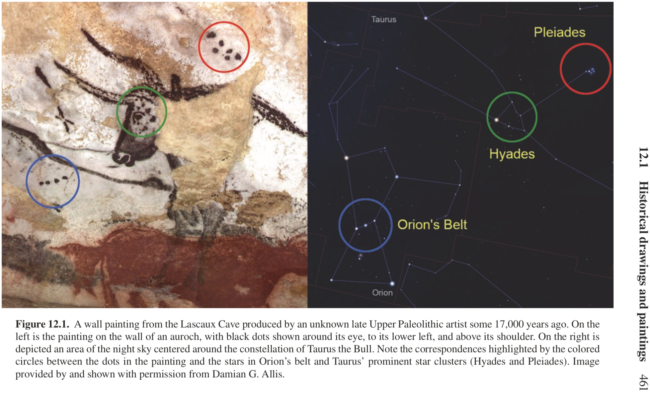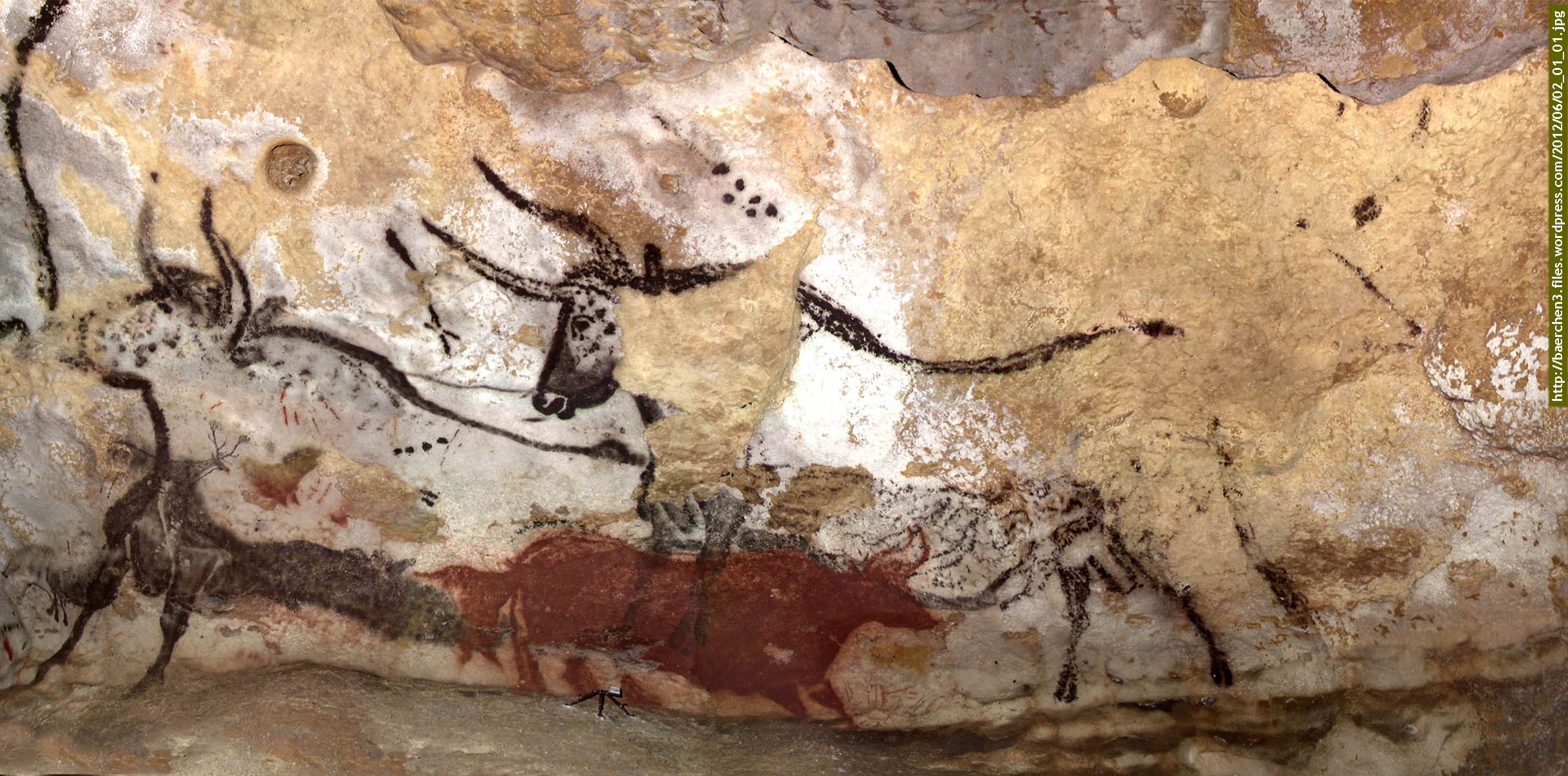Above: One of my all-time favorite images – a mural within the Lascaux Caves, possibly depicting three (now) prominent asterisms in the nighttime skies of winter.
I had been forwarded along a link from the now-defunct spacetoday.org site back in '08 or '09 about a possibly astronomical origin to one particular wall painting within the Lascaux Caves in southwestern France. Someone, either in an expedition or with photos from the documentation, must have had some amateur astronomy background (because most professional astronomers only enter caves when they’re obtaining data) and noticed that the groupings of stars on either side of one connect-the-dots now-extinct auroch (note the timing here – the bull is, astronomically-speaking, a later invention) had the right placement – and nearly the right counts – to maybe, kinda, sorta, possibly be as if someone had drawn the Orion Belt stars (and their collective +1) and a 25x zoom of our second-closest open cluster – the Pleiades (M45) – on either side of a cluster of black dots on an auroch’s head that could represent our closest open cluster – the Hyades.
This type of ancient astronomy history sticks *hard* in my brain, leading to the usual scouring of information online for other reports, images, refutations, etc. This then lead to my including the story way back in a November, 2009 constellation-of-the-month article for the SAS's Astronomical Chronicle and, with clarifying image, in the December 2016 article of the short-lived Upstate New York Stargazing series.
For someone wanting the unmodified image from the mural, there remains a high-res download available from baerchen3.wp.com.
It should come as no surprise that our ancestors would want to take the most mystical part of their day – the night – inside with them. There is no shortage of civilizations combining small clusters of stars in the sky with fantastical stories (see: the Northern Constellations), and seeing patterns in otherwise random visuals has probably been a solid feature in our brains far longer than any crafted image we’re likely to find buried in any ancient community (see: Pareidolia).

If, in fact, this mural was intended to represent the arrangement of what we know as Orion’s Belt, what we know as Taurus the Bull, and what we now call the Pleiades, it raises a host of questions. Is there somehow a direct, herd-migratory line from this cave painting to the walls of Babylon and into early western mythology? Was there a single painter? Was the head or were the stars painted first? If more than one person did it, same question – did someone add the stars to a head, or add the head to the stars? If we looked hard enough on either side of the current belt in the nighttime sky, would we see remnants of a far distant supernova in the background that might have appeared to the cave dwellers as a new, bright fourth star? Alternatively, how much trouble did Ukle-çois (remember, he’s French) get into by adding the fourth star to the Belt? Did the painter, intending to remove the fourth star after admonishing Ukle-çois for his vandalism, die in a violent way during the morning hunt for breakfast, leaving the fourth star there for all time? Is the right-most or the left-most fourth star the wrong one? Did anyone take fingerprints of these two stars to see which was different from the middle two to know which was the unwanted addition? Was the painting a deep thought of artistic expression by Jean-Ukle that should be deeply read into as a marker of Paleolithic human endeavor, or was it a particularly miserable rainy Tuesday night and Jean-Ukle was simply lamenting not being able to enjoy a bucolic moonlight stroll by spending the evening instead scribbling on a flat piece of cave while getting mildly blotto from the carbon monoxide?
We may never have the answers to these questions.

In the meantime, I have ended up contributing to the astronomical literature in the tiniest of ways to this earliest of anti-memes (because it did not come to you – you had to go to it) in the newly printed 3rd Edition of Nick Kanas’ excellent (e)book “Star Maps: History, Artistry, and Cartography,“ available at amazon and wherever fine Springer Praxis books are sold.
He’s a fellow amateur astronomer, so I liked him already. Additionally (from the amazon bio)…
Dr. Nick Kanas is an Emeritus Professor of Psychiatry at the University of California, San Francisco, where he directed the group therapy training program and wrote a book entitled Group Therapy for Schizophrenic Patients. For over 20 years, he conducted research in group therapy, and for over 15 years after that he was the Principal Investigator of NASA-funded psychological research on astronauts and cosmonauts. In 1999, Dr. Kanas received the Aerospace Medical Association Raymond F. Longacre Award for Outstanding Accomplishment in the Psychological and Psychiatric Aspects of Aerospace Medicine. In 2008, he received the International Academy of Astronautics Life Science Award. He has over 230 scientific publications.
Dr. Kanas is the coauthor of Space Psychology and Psychiatry (now in its 2nd edition), which won the 2004 International Academy of Astronautics Life Science Book Award. In 2015, he authored Humans in Space: The Psychological Hurdles, which won the 2016 International Academy of Astronautics Life Science Book Award.
Dr. Kanas has been an amateur astronomer for over 50 years. He has collected antiquarian celestial maps for over 30 years and has given talks on the history of celestial cartography to amateur and professional groups. He is the author of Star Maps: History, Artistry, and Cartography (now in its 2nd edition), and Solar System Maps: From Antiquity to the Space Age. An avid science fiction reader, Dr. Kanas has given talks and participated on panels at numerous World Science Fiction Conventions. He has published articles for Analog Science Fiction and Fact magazine and won the Analog AnLab 2015 readers’ poll award for Best Fact Article of the year. He has published three science fiction novels for the Springer Science and Fiction series: The New Martians, The Protos Mandate, and The Caloris Network. Except for his group therapy book, all of his books are published by Springer.
Check his website (nickkanas.com), follow him on twitter (@nick_kanas), give a listen to an interview on The Space Show (and subscribe and support it, as it is excellent), and go buy a copy of the book.
